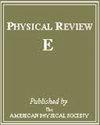混合型系统的间距比。
IF 2.4
3区 物理与天体物理
Q2 PHYSICS, FLUIDS & PLASMAS
引用次数: 0
摘要
连续电平间距比的分布被广泛用于区分可积量子光谱和混沌量子光谱,主要是因为它避免了数值谱展开。与使用Rosenzweig-Porter方法获得混合型系统中水平间距的Berry-Robnik分布一样,本文将该方法推广到解析导出由独立可积块和混沌块组成的随机矩阵的间距比分布。我们利用随机矩阵理论在量子踢转子和hsamnon - heiles系统等范式模型中数值证实了这一分析结果。本文章由计算机程序翻译,如有差异,请以英文原文为准。
Spacing ratios in mixed-type systems.
The distribution of the consecutive level-spacing ratio is now widely used as a tool to distinguish integrable from chaotic quantum spectra, mostly due to its avoidance of the numerical spectral unfolding. Like the use of the Rosenzweig-Porter approach to obtain the Berry-Robnik distribution of level spacings in mixed-type systems, in this paper, we extend this approach to analytically derive the distribution of spacing ratios for random matrices comprised of independent integrable blocks and chaotic blocks. We have numerically confirmed this analytical result using random matrix theory in paradigmatic models such as the quantum kicked rotor and the Hénon-Heiles system.
求助全文
通过发布文献求助,成功后即可免费获取论文全文。
去求助
来源期刊

Physical Review E
PHYSICS, FLUIDS & PLASMASPHYSICS, MATHEMAT-PHYSICS, MATHEMATICAL
CiteScore
4.50
自引率
16.70%
发文量
2110
期刊介绍:
Physical Review E (PRE), broad and interdisciplinary in scope, focuses on collective phenomena of many-body systems, with statistical physics and nonlinear dynamics as the central themes of the journal. Physical Review E publishes recent developments in biological and soft matter physics including granular materials, colloids, complex fluids, liquid crystals, and polymers. The journal covers fluid dynamics and plasma physics and includes sections on computational and interdisciplinary physics, for example, complex networks.
 求助内容:
求助内容: 应助结果提醒方式:
应助结果提醒方式:


